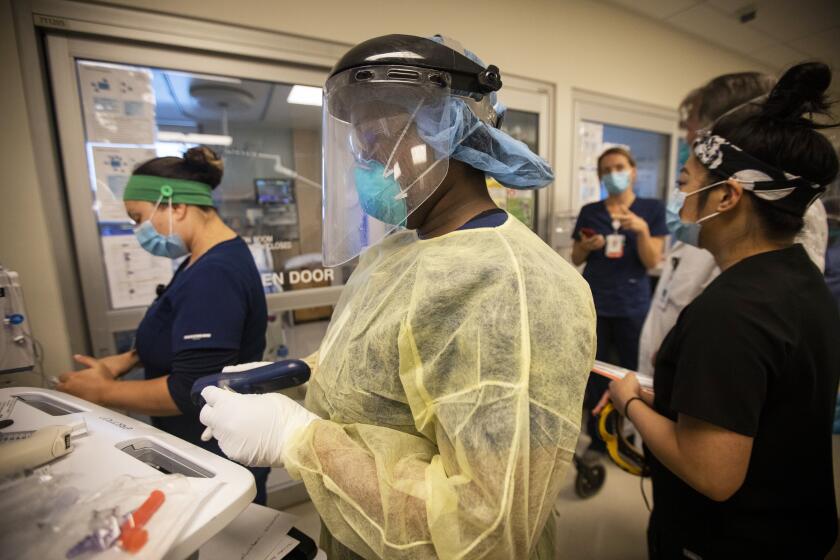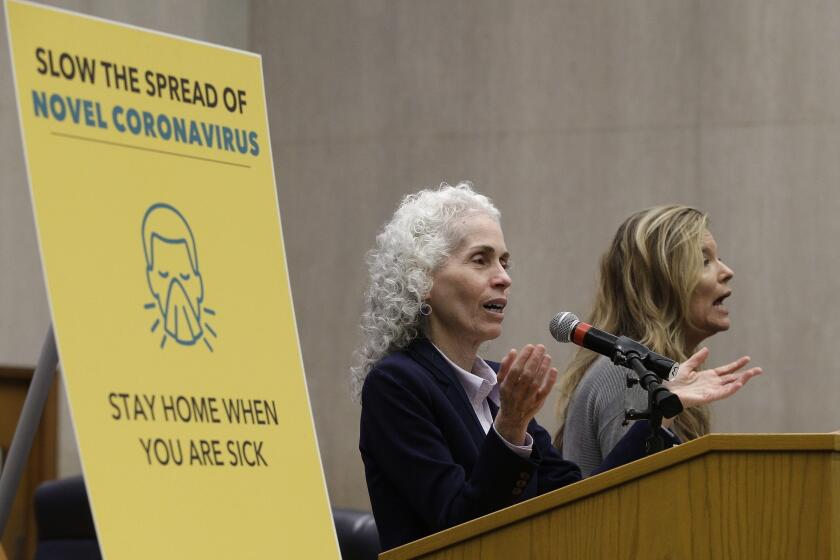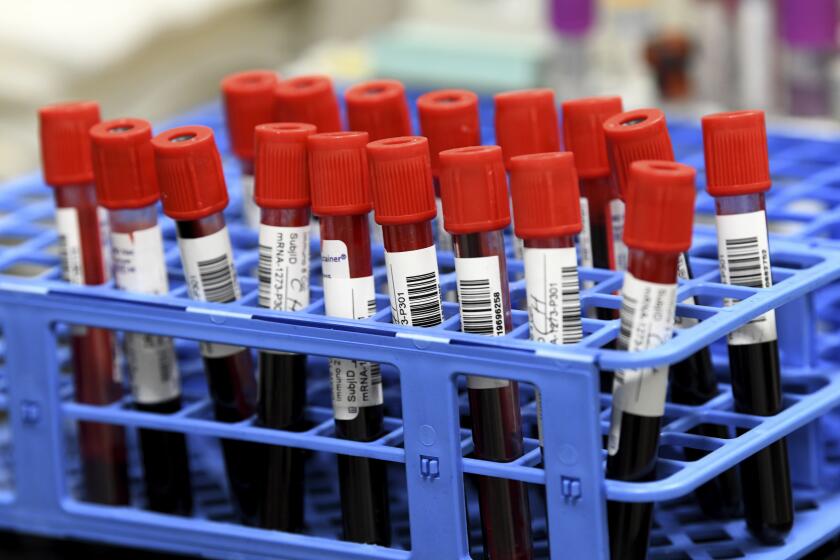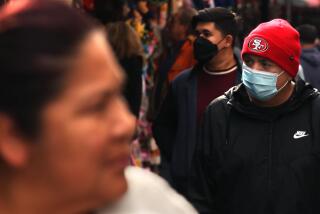California coronavirus shutdown will last through Christmas as deaths explode past 20,000

For millions of Californians, the COVID-19 pandemic will provide a most unwelcome gift this Christmas: a wide-ranging shutdown imposed as the state grapples with its most massive and dangerous surge in infections and hospitalizations to date.
Monday provided even more devastating news: More than 20,000 cumulative deaths and more than 34,000 new coronavirus cases reported Monday alone, according to The Times’ county-by-county tally of infections. That shatters the previous single-day record, set Friday, when 22,369 coronavirus cases were tallied.
And for the first time, more than 10,000 people with coronavirus infections are now hospitalized in California — quadruple the number from Halloween.
The stay-at-home restrictions that took hold at 11:59 p.m. Sunday across Southern California and the San Joaquin Valley will remain in place for at least three weeks, meaning those regions will not be able to emerge from the state’s latest stay-at-home order until Dec. 28 at the earliest.
Five counties in the San Francisco Bay Area also announced last week that they were proactively implementing the new restrictions and planned to keep them in place until at least Jan. 4.
Combined, those regions are home to some 33 million Californians, representing 84% of the state’s population.
The coronavirus wave engulfing California doesn’t even reflect anyone who may have gotten sick during Thanksgiving.
The timing of the rules is the latest blow, in a year full of them, for many businesses — which have been battered by coronavirus-related restrictions and hoped the holiday shopping season would throw them a desperately needed lifeline — and to the psyche of Californians, who for months have lived with the threat of the coronavirus hanging over their heads.
Officials, though, have said desperate times call for drastic measures. The number of new daily coronavirus cases has skyrocketed to a level that would have been unthinkable just weeks ago. Hospitals are already contending with an unprecedented wave of more than 10,000 COVID-19 patients.
“Once people die, they’re gone from our lives forever — and there’s no way to measure that impact at all,” L.A. County Public Health Director Barbara Ferrer said during a briefing Monday. “There’s no value you really can place on a person’s husband or daughter or their friend or their loved one. And every death is a tragedy, particularly those deaths that, in some ways, if we were all better at doing our part, we could be preventing right now.”
Gov. Gavin Newsom has announced a stay-at-home order affecting most of California.
As bleak as things are now, the ceiling of the surge may be yet to come, as experts say the ramifications of travel and gathering for the Thanksgiving holiday have yet to be fully realized.
Cases that stem from “dinner tables or activities and plans, travel through Thanksgiving, are going to show up right about now,” said Dr. Mark Ghaly, California’s Health and Human Services secretary, and “we know we’ll be seeing that for many days to come.”
“We believe,” he said at a Monday briefing, “that the levels of transmission that we’ve been reporting so far will likely continue to go up some because of those activities around Thanksgiving.”
The pandemic that has killed nearly 20,000 Californians and brought an economy to its knees entered a treacherous phase Sunday as much of the state began a new stay-at-home order and coronavirus cases soar.
Gov. Gavin Newsom announced the new round of restrictions last week, saying stricter intervention was needed to shore up the state’s hospital system and make sure intensive care beds remained available.
The state’s latest strategy carves California into five regions: Southern California, the San Joaquin Valley, the Bay Area, the Greater Sacramento area and rural Northern California.
A region is required to implement a state-defined stay-at-home order — which restricts retail capacity to 20% and shuts down outdoor restaurant dining, hair salons, nail salons, public outdoor playgrounds, card rooms, museums, zoos, aquariums and wineries — if its available ICU capacity drops below 15%.
Southern California and the San Joaquin Valley are already below that threshold, and as of Monday their ICU availability had tumbled to 10.9% and 6.3%, respectively.
The Southern California region encompasses Imperial, Inyo, Los Angeles, Mono, Orange, Riverside, San Bernardino, San Diego, San Luis Obispo, Santa Barbara and Ventura counties.
On Monday, Ventura, Santa Barbara, and San Luis Obispo counties announced that they may seek approval from the state to separate from the Southern California region and create their own Central Coast region.
The counties will request to be considered a separate region to assess restrictions to curb the spread of the virus if their ICU capacity exceeds 15% in the next three weeks, according to a Ventura County press release.
“A smaller regional approach is important for our community members and struggling businesses,” said County Executive Officer Mike Powers. “We believe it’s reasonable to have the Central Coast as one region instead of including our County with over half the State’s population in the current Southern California Region.”
The area defined as the San Joaquin Valley covers Calaveras, Fresno, Kern, Kings, Madera, Mariposa, Merced, San Benito, San Joaquin, Stanislaus, Tulare and Tuolumne counties.
Some experts say a harm-reduction approach to public health — educating people how to mitigate risk in their activities — would be more effective than all-or-nothing pleas to abstain from contact with other people.
Both Greater Sacramento (20.3%,) and Northern California (28.2%) remain above the ICU threshold for now.
So does the Bay Area, at 25.7%. Health officials there aren’t waiting, however, and have already decided to apply the order — which went into effect in San Francisco, Santa Clara and Contra Costa counties on Sunday; in Alameda County on Monday; and will do so in Marin County on Tuesday.
“We cannot wait until after we have driven off the cliff to pull the emergency brake,” Dr. Sara Cody, Santa Clara County’s health officer, said in a statement.
The latest restrictions have been a source of controversy, however. Critics have demanded to see data justifying the latest rules and questioned whether they will play a significant role in turning the tide of the pandemic — particularly if residents don’t abide by them and law enforcement departments decline to enforce them.
Some have also objected to the state taking a regional view, saying they shouldn’t be punished because of their neighboring counties’ circumstances.
Though the additional restrictions are undoubtedly a hardship for many, Ghaly said they were “required to make sure we get through the surge as quickly as possible and saving as many lives and preventing as many infections as we possibly can.”
California has seen a sustained and shocking rise in coronavirus cases and hospitalizations over the last few weeks — with numbers surging to levels far beyond those seen at any other point in the pandemic.
Statewide, average daily coronavirus cases have jumped sixfold since early October, hospitalizations have quadrupled since late October, and average daily deaths have nearly tripled in the last month.
Over the last week, California has averaged 20,414 cases per day, a 78.3% increase from two weeks ago, according to data compiled by The Times.
Roughly 240,000 Californians have tested positive for the coronavirus in the last 14 days. That number is larger than the entire population of the city of San Bernardino.
There are now 10,070 coronavirus-positive patients hospitalized statewide and 2,360 are in intensive care, according to numbers Newsom presented Monday. Both those figures are all-time highs.
An average of 112 Californians have died from COVID-19 every day over the last week.
“I think we have moved from characterizing this as a surge, in my mind, to being basically a viral tsunami in terms of its size,” said Dr. Robert Kim-Farley, a professor at the UCLA Fielding School of Public Health, medical epidemiologist and infectious disease expert.
In Los Angeles County, the state’s most populous, health officials reported more than 10,500 new cases Sunday, an unprecedented number for a single day. Hospitalizations for COVID-19 have surpassed 3,000, and Ferrer said that number could rise dramatically in the next few weeks as the full toll of the Thanksgiving holiday comes into view.
Given the county’s recent sky-high case counts, Ferrer said officials are projecting that daily hospitalizations could surpass 4,000 this month — with daily deaths potentially rising to 65 soon thereafter.
Before the latest surge, the county had never seen recorded 2,300 COVID-19 patients hospitalized in a single day.
“These numbers reflect actions we took in late November, and we can’t take those actions back,” Ferrer said. “What we can do is change our actions today so that, two to three weeks from now, we’re not reporting a similarly disastrous cascade of events.”
How could scientists race out COVID-19 vaccines so fast without cutting corners
Though the pandemic has reached crisis levels in California, state officials say there is light at the end of the tunnel as companies begin to roll out their initial shipments of COVID-19 vaccines.
Newsom said Monday the state was planning to receive 2.16 million doses of vaccine this month — with delivery expected to start by next week.
“Hope is on the horizon,” he said.
More tools are also coming online. Starting Thursday, Californians will be able to opt into a smartphone-based system, turning on COVID-19 exposure notifications in their iPhone settings or downloading the CA Notify app in the Google Play Store.
Some residents can expect to get a notification by phone alerting them that the program is available.
State officials hope the Bluetooth-based technology — which doesn’t collect location data or people’s identities — will help slow the transmission of the novel coronavirus by quickly notifying people when they’ve been exposed to someone who later tests positive for the disease.
Newsom has also named a new general in the battle against COVID-19. He announced Monday that he had appointed Tomás Aragón as director of the California Department of Public Health.
Aragón had been health officer for the city and county of San Francisco.
“We’re very, very enthusiastic to have him now on the team,” Newsom said, “to continue to supplement our efforts as we move into this next and challenging phase.”
The appointment requires confirmation from the state Senate.
Times staff writers Alex Wigglesworth, Jack Dolan and Sean Greene and Lyndsay Winkley of the San Diego Union-Tribune contributed to this report.
More to Read
Sign up for Essential California
The most important California stories and recommendations in your inbox every morning.
You may occasionally receive promotional content from the Los Angeles Times.

















